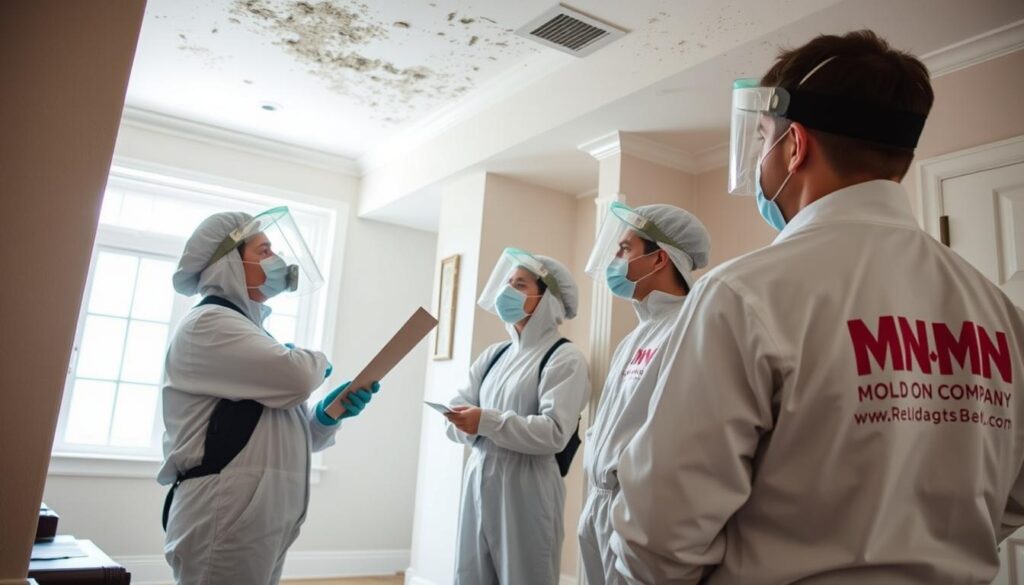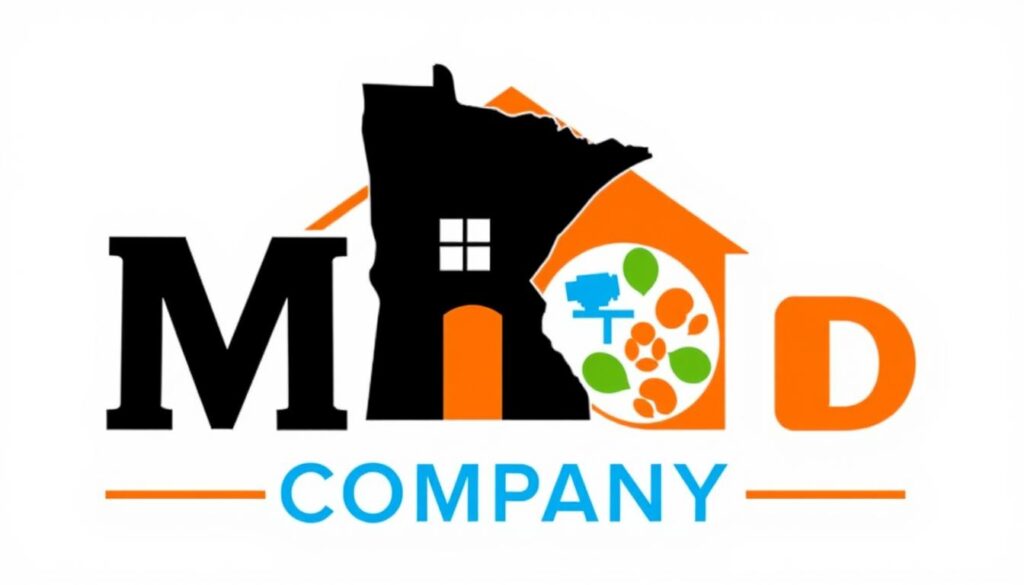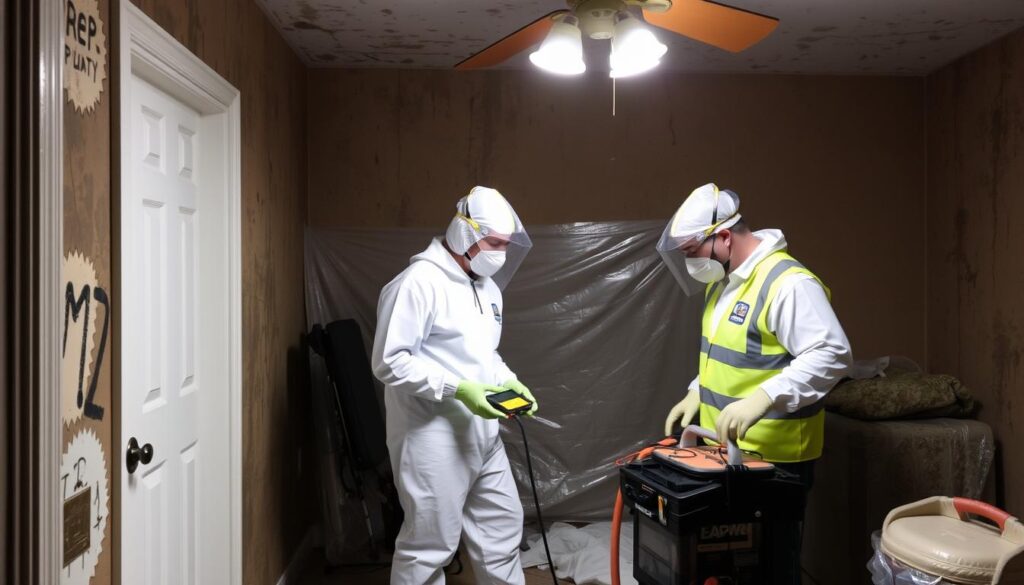Did you know that mold removal in the U.S. can cost between $1,128 and $3,450? Homeowners usually pay around $2,230 on average. This shows how crucial it is to pick the right mold removal experts. They need special knowledge, certifications, and tools to do the job right and safely.
In this guide, we’ll look at who can remove mold from your house. We’ll also cover the differences between mold inspectors and remediators. Plus, we’ll talk about the important certifications for mold removal specialists and the steps in professional mold remediation. By the end, you’ll know how to choose the best mold removal service for your home.

Key Takeaways
- Mold removal needs special skills and certification, with SERVPRO offering 24/7 emergency service and free mold checks.
- The cost of professional mold removal is usually between $1,128 and $3,450, based on the problem’s size and location.
- It’s important to hire certified mold specialists to ensure the job is done correctly and safely. Trying to remove mold yourself is not recommended.
- Mold inspectors and remediators have different roles. Inspectors find the problem, and remediators fix it.
- The right mold removal process includes assessing, containing, removing, cleaning, and verifying the job is done.
Understanding Professional Mold Removal Services
Hiring mold remediation contractors is key when dealing with mold in homes. These experts have the right tools and knowledge to safely remove mold. They start with an assessment and then thoroughly clean your home to make it safe again.
Types of Mold Remediation Specialists
A team of professionals works on mold removal. This includes environmental hygienists who check how much mold there is and certified mold removal specialists who do the cleaning. They use special equipment to get rid of mold safely and follow the best practices.
Importance of Certified Professionals
It’s important to choose certified mold removal specialists. They are trained and licensed to handle mold safely. They follow strict rules to prevent mold spores from spreading, keeping your home and family safe.
Role of Environmental Testing
Environmental testing is a big part of mold removal. Environmental hygienists do tests like air quality checks to find out how much mold there is. This helps them plan the best way to get rid of the mold.
| Mold Remediation Service | Average Cost |
|---|---|
| Mold Remediation (small area) | $373 – $2,361 |
| Mold Remediation (large area) | $2,361 – $7,000 |
| Black Mold Removal | $800 – $7,000 |
The cost of mold removal services can change a lot. It depends on how much mold there is, what kind it is, and where your home is. But, it’s worth it to get certified mold remediation contractors to fix the problem right.
“Mold can develop within 48 hours after a water intrusion event, so it’s essential to act quickly and hire professional remediation services to address the issue.”
Who Can Remove Mold from a House: Expert Analysis
Mold can grow fast in damp places, spreading in just 24-72 hours. The U.S. Environmental Protection Agency (EPA) says to call mold removal professionals for any mold over 10 square feet. Licensed mold contractors and certified remediation experts use special tools and methods to safely remove mold.
Mold Gone, a top mold removal company in the DC area, has over a decade of experience. They help thousands of homes and businesses with mold problems. They do detailed inspections, air quality tests, and full inspections to find and fix mold issues.
| Mold Inspection Service | Price |
|---|---|
| Visual Inspection | $250 |
| Air Quality Inspection | $295 |
| Full Inspection | $495 |
Mold Gone is known for their honest and top-notch work. They are licensed, bonded, and insured. Their team is highly trained and certified remediation experts. They have an A+ rating from the Better Business Bureau and a 5-star Yelp rating.
“Mold Gone has been a game-changer for our family. Their thorough inspection and effective remediation process have finally allowed us to breathe easy in our home again.”
When facing a mold issue, it’s crucial to rely on licensed mold contractors and certified remediation experts. They ensure your home is safe and healthy for everyone.
Key Differences Between Mold Inspectors and Remediators
Understanding the roles of mold inspectors and remediators is key when dealing with mold in homes or buildings. They both play important parts in managing mold, but their focus and methods are different.
Inspection Process and Equipment Used
Mold inspectors check how much and what kind of mold there is. They use tools like moisture meters and air quality testers. They look closely at the property, take samples, and write a detailed report.
Remediation Techniques and Standards
Mold remediators focus on getting rid of the mold. They use a detailed plan that includes stopping mold spread, cleaning, and drying. They follow strict standards to safely remove mold.
Documentation and Reporting Requirements
Both inspectors and remediators are important for keeping records. Inspectors write reports on the mold problem and what to do next. Remediators document their work, including how they cleaned and what they did.
Knowing what mold inspectors and remediators do is crucial for tackling mold problems well. Together, they can find the mold’s source, plan how to fix it, and make the indoor space safe and healthy again.
| Mold Inspection | Mold Remediation |
|---|---|
| Focuses on assessment and testing | Handles removal and cleanup |
| Uses moisture meters, air quality testing devices | Employs containment, air filtration, cleaning, and drying techniques |
| Provides detailed assessment reports | Documents the entire remediation process |
Knowing the differences between mold inspectors and remediators helps homeowners and property managers make smart choices. This ensures a thorough approach to solving mold problems, making indoor spaces safe and healthy.
The Essential Certifications for Mold Removal Specialists
Choosing the right professionals for mold removal is key. They must have the right qualifications and certifications. This ensures they can do the job safely and effectively, following industry standards.
The IICRC (Institute of Inspection, Cleaning and Restoration Certification) is a top certification in mold removal. Professionals with this certification have deep knowledge of how to safely remove mold. They know the best techniques and safety steps.
Some states also require mold removal specialists to have specific licenses or qualifications. For example, in Virginia, a new law requires them to have an IICRC certification for residential work.
Other important certifications and qualifications include:
- NAMP (National Association of Mold Professionals) certification
- MICRO (Mold Inspection Consulting & Remediation Organization) Certified Mold Inspector (CMI) and Certified Mold Remediation Contractor (CMRC) courses
- EPA lead certification, needed for renovations that disturb lead paint
Choosing a mold removal specialist with the right IICRC certification, mold remediation qualifications, and professional credentials ensures a safe and effective job. This protects your home and the health of its occupants.
“The NAMP Certification Course is America’s oldest and most respected certification course.”

When picking a mold remediation provider, look at their reputation and track record. Companies like MoldPro LLC and Rytech Restoration are known for quality service. They have good ratings and focus on certified technicians and quick response times.
Professional Mold Removal Process and Timeline
Removing mold from a home is a detailed process that needs careful attention and skill. Mold remediation experts follow strict steps to ensure the mold remediation process is done right and safely. Here are the main steps in professional mold removal:
Initial Assessment and Containment
The first step is a detailed assessment to find out how bad the mold is. This includes testing the air and checking the affected areas. After that, the specialist sets up barriers, like sealing off the area and stopping the HVAC, to stop mold spores from spreading.
Removal and Cleaning Procedures
With everything contained, the team starts the removal and cleaning process. They carefully take out any mold-damaged materials like drywall or insulation. Then, they clean non-porous surfaces with special professional cleaning procedures and treatments to get rid of all mold.
Post-Remediation Verification
After cleaning, the specialist does verification testing to make sure the area is clean. This includes air quality tests, moisture checks, and a visual check to confirm no mold is left. Only when the area passes these verification tests is the job done.
The time it takes to remove mold can vary a lot. It depends on how much mold there is, how big the area is, and what materials are involved. Generally, it can take a few days to a week or more. Testing and any repairs or restoration add more time.
It’s key to use professional cleaning procedures and do thorough verification testing to make sure mold is fully gone and won’t come back. Getting a certified mold remediation specialist is the best way to ensure a complete and successful mold removal.
Benefits of Hiring Licensed Mold Professionals
Choosing licensed mold professionals for your home’s mold issues has many benefits. They have the skills, tools, and methods to remove mold effectively. This ensures your property and health are protected for a long time.
Professional mold removal benefits include:
- They find hidden mold growth with advanced tools and methods.
- They contain and isolate mold areas to stop it from spreading.
- They use special techniques and EPA-approved products for mold removal.
- They fix moisture problems to stop mold from coming back.
- They help with insurance claims to cover the cost of removal.
Certified specialist advantages are:
- They follow strict standards and licensing, ensuring quality work.
- They are trained in mold assessment, remediation, and safety.
- They use the latest equipment and safety gear to protect everyone.
- They give detailed reports and warranties for the mold removal process.
By picking licensed mold professionals, you know your property is in good hands. They solve mold problems efficiently and safely. Their skills and commitment to best practices make them the best choice for mold issues.
“Hiring a certified mold remediation specialist is the best way to ensure the job is done right and that the mold problem is addressed at its root cause.”
Insurance Considerations and Professional Mold Removal
Understanding your insurance coverage is key when dealing with mold damage at home. Mold remediation can be expensive and complex. But, the right insurance policy can offer financial protection. Yet, not all mold issues are covered, and the claims process can be tough.
Coverage Options and Requirements
Mold insurance claims often aren’t covered if the damage was caused by neglect. For example, a leaky pipe under the kitchen sink for months can lead to mold. Insurance usually doesn’t cover mold removal unless it’s caused by a covered event. Coverage is often limited.
Documentation for Claims
To make the claims process smoother, work with professional mold remediation experts. They can provide detailed documentation, like inspections and remediation plans. This helps show the mold problem’s extent and the steps needed for removal. It increases your claim’s success chances.
Working with Insurance Adjusters
Dealing with insurance claims can be overwhelming. But, companies like SERVPRO can help by working with adjusters. They ensure the right documentation is given and the process is efficient. This saves you from extra hassle.
Knowing your insurance and working with certified professionals can help you use your mold damage insurance and remediation coverage effectively. By following the right claims process, you can reduce financial stress and achieve a good outcome.
Emergency Mold Response and Containment
Mold issues in homes or buildings need quick action. Mold spores can spread fast, within 24-48 hours, posing health risks and causing damage. That’s why emergency mold services and rapid response remediation are key to stopping the problem and preventing it from getting worse.
Experts in mold remediation are ready 24/7 to respond quickly. They set up negative air chambers and use special air filters to catch mold spores. This stops them from spreading in the affected area.
- Comprehensive mold assessment to determine the extent of the problem
- Immediate containment measures to stop the spread of mold spores
- Customized remediation plans tailored to the unique needs of the property
Every mold damage case is different. A rapid response from certified pros is vital. They quickly find the cause, contain and clean it, and make the indoor space safe and healthy again.

Effective mold remediation is key to protecting buildings and keeping people healthy. Quick action and following the right steps can reduce damage and health risks.
Why DIY Mold Removal Isn’t Recommended
Trying to fix a mold problem in your home might seem easy. But the Environmental Protection Agency (EPA) says not to try it yourself if the area is over 10 square feet. They say professional mold removal services are safer and more effective. They make sure mold is fully removed and your health is protected.
Mold can be tricky, needing special cleaning methods for each type. Without the right tools, like air filters and machines that suck out mold, you might spread it more. Also, not wearing the right protective gear can let you breathe in harmful mold spores, which can harm your health.
Choosing professional vs DIY mold removal services saves you time and keeps you safe from risks of self-remediation. Mold removal experts use special tools and methods. They safely remove mold, throw away contaminated stuff, and make your home safe again. This way, you won’t have to worry about mold coming back, giving you peace of mind.
FAQ
What is the difference between mold inspectors and mold remediators?
Mold inspectors check and test for mold. Remediators remove and clean it. Inspectors use special tools to find and measure mold. Remediators use safe methods to get rid of mold.
What certifications should I look for in a mold specialist?
Look for IICRC (Institute of Inspection, Cleaning and Restoration Certification) and state licenses. These show they know how to safely remove mold.
Why is experience important for mold removal professionals?
Experienced professionals know how to safely remove mold. They use the latest technology and follow strict safety rules. This ensures mold is completely gone.
What is the role of an environmental hygienist in a mold case?
Environmental hygienists test air quality and collect samples. They analyze these to find out how much mold there is. Their work helps guide the cleanup.
Can a general contractor handle mold removal in my home?
General contractors might know some about mold removal. But, it’s best to hire experts. They have the right tools and knowledge to do the job right.
What are the benefits of hiring licensed mold professionals?
Licensed professionals ensure mold is removed safely. They follow strict rules and document everything. This helps with insurance claims and guarantees quality work.
What questions should I ask to determine a mold specialist’s expertise?
Ask about their certifications, experience, and equipment. Find out their removal methods and if they have references. This helps you choose the right professional.
How do insurance implications factor into hiring mold removal professionals?
Insurance often requires certified professionals. They ensure proper documentation and follow industry standards. This helps with insurance claims and coverage.
Do mold specialists work closely with insurance providers?
Yes, good mold specialists work well with insurance companies. They know what’s needed for claims. This makes the process easier for homeowners.
How can I verify the references and credentials of a mold removal professional?
Check references, online reviews, and certifications. Talk to past clients and confirm credentials. This ensures you’re hiring a reliable professional.
Source Links
- mold-remediation-procedure – https://www.nyc.gov/site/nycha/residents/mold-busters/mold-remediation.page
- How Much Does Mold Remediation Cost? (2024 Guide) – https://www.thisoldhouse.com/foundations/reviews/mold-remediation-cost
- How Much Does Mold Remediation Cost? (2024) – https://www.architecturaldigest.com/reviews/home-improvement/mold-remediation-cost
- Mold Removal vs Mold Remediation, What’s the Difference? – https://www.servpro.com/resources/mold-remediation/mold-removal
- How Much Does Professional Mold Remediation and Removal Cost? – https://www.houselogic.com/organize-maintain/home-maintenance-tips/mold-remediation-cost/
- Fairfax, VA Mold Inspection & Mold Remediation – https://www.moldgone.net/fairfax-va-mold-inspection-mold-remediation/
- Professional Mold Removal Services | Green Home Solutions – https://www.greenhomesolutions.com/our-services/mold-testing-and-removal/
- What is the Difference Between Mold Removal and Mold Remediation | COIT – https://www.coit.com/blog/general-home-cleaning/what-difference-between-mold-removal-and-mold-remediation
- Mold Removal vs. Mold Remediation – https://atirestoration.com/blog/mold-removal-vs-mold-remediation/
- The Difference Between Mold Removal and Remediation – https://moldzero.com/the-difference-between-mold-removal-and-remediation/
- When It Comes To Mold Remediation, Certifications Matter | MoldPro LLC – https://moldprollc.com/when-it-comes-to-mold-remediation-certifications-matter/
- Certified Mold Remediation Contractor Course Online – https://www.moldcareer.com/training-certification/4/5/195/MICRO-Certified-Mold-Remediation-Contractor-CMRC-Course/?srsltid=AfmBOooatjPBLvX9r0nCQA6yh0eXtU_bDzuWB4kfjU9XOg3EZxu4sqbV
- IICRC Mold Remediation Certification Required Under New Virginia Law – https://www.randrmagonline.com/articles/90808-iicrc-mold-remediation-certification-required-under-new-virginia-law
- How Long Does Mold Remediation Take? – https://greenworksllc.com/how-long-does-mold-remediation-take/
- How Long Does Mold Remediation Take? | COIT – https://www.coit.com/blog/healthy-home/how-long-does-mold-remediation-take
- What to Expect During the Mold Remediation Process – https://callservicefirst.com/what-to-expect-during-the-mold-remediation-process/
- Mold Frequently Asked Questions – https://dol.ny.gov/mold-frequently-asked-questions
- The Top 5 Reasons For Using a Professional Mold Remediation Service | COIT – https://www.coit.com/blog/healthy-home/top-5-reasons-using-professional-mold-remediation-service
- Does Homeowners Insurance Cover Mold? – https://www.progressive.com/answers/does-homeowners-insurance-cover-mold/
- Does Homeowners Insurance Cover Mold? – NerdWallet – https://www.nerdwallet.com/article/insurance/does-homeowners-insurance-cover-mold
- Mold Cleanup and Mold Restoration | Servpro Industries, LLC. – https://www.servpro.com/resources/mold-remediation/mold-removal-process
- MANAGING A MOLD INFESTATION: GUIDELINES FOR DISASTER RESPONSE – https://ccaha.org/resources/managing-mold-infestation-guidelines-disaster-response
- Mold Remediation and Removal Services | BMS CAT – https://www.bmscat.com/mold-remediation/
- Black Mold Removal-Here’s Why You Shouldn’t DIY It – https://cvecorp.com/black-mold-removal-heres-why-you-shouldnt-diy-it/
- 10 Dangers of DIY Home Mold Removal – First Call Cleaning and Restoration – https://firstcallnc.com/blog/mold-removal-dangers/
- Don’t DIY — Why You Should Rely on the Pros for Mold Removal | Gold Eagle Services – https://goldeagleservices.com/dont-diy-why-you-should-rely-on-the-pros-for-mold-removal/
